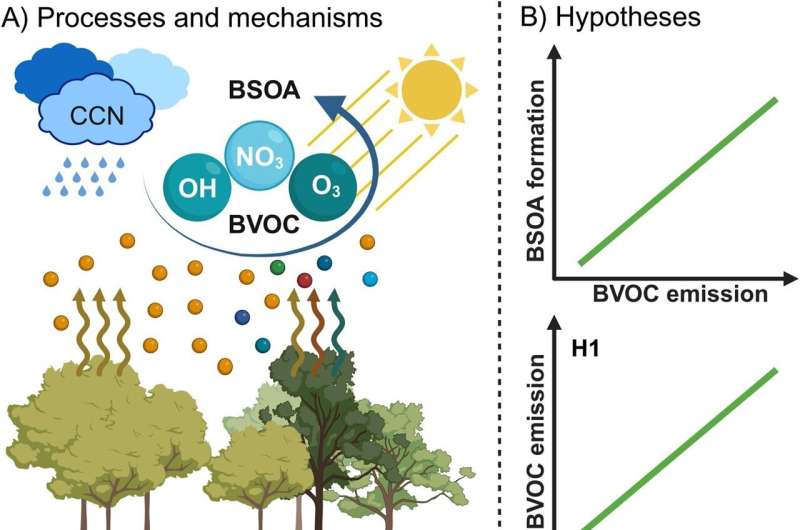This article has been reviewed according to Science X's editorial process and policies. Editors have highlighted the following attributes while ensuring the content's credibility:
fact-checked
peer-reviewed publication
trusted source
proofread
How forests smell: Investigating how biodiversity affects the atmosphere

Plants emit odors for a variety of reasons, such as to communicate with one another, to deter herbivores or to respond to changing environmental conditions. An interdisciplinary team of researchers from Leipzig University, the Leibniz Institute for Tropospheric Research (TROPOS) and the German Center for Integrative Biodiversity Research (iDiv) carried out a study to investigate how biodiversity influences the emission of these substances.
For the first time, the researchers were able to show that species-rich forests emit less of these gases into the atmosphere than monocultures. The findings are published in the journal Communications Earth & Environment.
Plants produce a variety of organic compounds to communicate with each other and with their environment. These are known as biogenic volatile organic compounds (BVOCs), such as terpenes, which give plants their characteristic scent and help to repel pests.
These substances not only act as chemical signals, but they also play a role in regulating climate, air quality and atmospheric chemistry. This is because these BVOCs emitted by plants form biogenic secondary organic aerosols (BSOAs) in the air, i.e., particles in the atmosphere. These aerosols in turn affect air quality, cloud formation and the climate.
MyDiv Experiment: Measurements in plots with different tree species
But how do emissions and concentrations of aerosols in the air change as biodiversity declines or plants are stressed by drought? The interdisciplinary team led by scientists Dr. Anvar Sanaei and Professor Alexandra Weigelt from Leipzig University and other researchers from TROPOS and iDiv investigated this question.
The scientists collected the data at the MyDiv tree diversity experimental site. The site, near Bad Lauchstädt in Saxony-Anhalt, covers around two hectares and has 80 plots with 10 tree species growing together in monocultures or mixtures of different species. For the study, the team spent almost two weeks collecting air samples from 10 of the 11x11 meter plots, which grew four tree species—rowan, wild cherry, common ash and sycamore—in different combinations.
Fewer plant odors, fewer risks
"In the field, we measured BVOCs and BSOA compounds in 10 plots of varying tree diversity. Our results show that the amount of BVOCs decreases with increasing biodiversity in most cases," says Dr. Sanaei, first author of the study and postdoctoral researcher at the Institute of Biology at Leipzig University. It is estimated that global BVOC emissions from vegetation will increase by around a third as a result of climate change.
"There are considerable uncertainties here. These precursor gases can form particles, which in turn can become cloud droplets. Whether BVOCs ultimately cool or warm the atmosphere depends on many factors and is difficult to predict. However, more biodiversity and fewer BVOCs would reduce the changes in the atmosphere and thus also the risks of climate change—including changes in precipitation," adds Professor Hartmut Herrmann from TROPOS.
The second part of the study shows how difficult it is to investigate these complex processes in the field: The team was unable to establish any clear correlations for BSOAs, which could be partly due to environmental influences, as the conversion of BVOC gases into BSOA particles takes a certain amount of time. At just under two weeks, the measurement campaign was also comparatively short. The team wants to continue the research because many questions remain unanswered.
Previously, it was thought that species-rich forests and grasslands released more gases into the atmosphere than species-poor ones. The reason for this was thought to be that species-rich systems produce more biomass because they can utilize resources such as light, water and nutrients more efficiently. More biomass then also means more leaf surface area from which the gases can be emitted.
"Our new results, however, suggest that the situation may be due to the fact that plants in species-rich forests and grasslands are under less stress. Compared to monocultures, they face fewer herbivores and less heat and drought. But this is just a hypothesis for now.
"Much more research is needed to better understand how biodiversity affects the atmosphere, where we need to look more closely at the microclimate, above- and below-ground stress on plants, and many other factors in long-term experiments," says Professor Nico Eisenhauer from iDiv.
More information: Anvar Sanaei et al, Changes in biodiversity impact atmospheric chemistry and climate through plant volatiles and particles, Communications Earth & Environment (2023). DOI: 10.1038/s43247-023-01113-9
Journal information: Communications Earth & Environment
Provided by Leipzig University




















